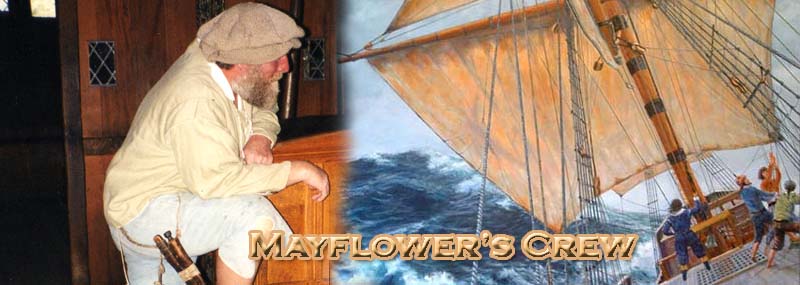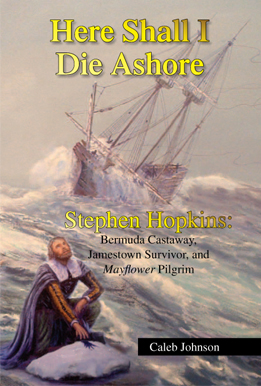The Mayflower would have been crewed by about thirty men. Of those, only a handful can be identified with historical records.
Ship's Master, Christopher Jones
The ship's master (the term "captain" was only used for military ships at this time) was Christopher Jones. He was born about 1570, the son of Christopher and Sybil Jones of Harwich, Essex, England. He lived in Harwich until about the age of 40, when he then moved to Rotherhithe, Surrey, England, a short distance from London on the river Thames. His first ship of record was called the Josian, named after his wife. He sold that ship about 1608, and purchased the Mayflower with three others. He had nine children, but most of them died in infancy. He was about fifty years old when he was hired to transport the Pilgrims to America onboard his ship.
Ship's Pilot and Master's Mate, John Clarke
John Clarke had been a ship's pilot on a voyage to Jamestown, Virginia in 1611, in the fleet that brought Sir Thomas Dale to govern the colony. He lived and worked ferrying cargo in the bay for about 40 days, until a Spanish ship came into the harbor. He was taken prisoner, tied up, and sailed first to Havana, Cuba, and later to Malaga, Spain, where he would be repeatedly interrogated by Spanish authorities. After five years imprisonment, he was released to the English in 1616. He took a load of cattle to Jamestown again in 1618, and was then hired for the Mayflower's voyage.
Master's Mate, Robert Coppin.
Not much is known about Robert Coppin, other than he claimed to have been to New England on a previous voyage and claimed to have some experience whaling. He may have come from the vicinity of Harwich, and a man of that same name invested a small sum to purchase a share in the Virginia Company of London in 1609.
Cooper (Barrel-maker), John Alden.
Twenty-one year old John Alden was hired in Southampton, England, where the Mayflower took on provisions, but he may also have originally been from Harwich, as there was an Alden family living there that was related, by marriage, to Master Christopher Jones. Alden's job was to build, repair and maintain the ship's barrels. This was a very important job, since everyone's food and drink were stored within those barrels. The Pilgrims' joint-stock company had agreed to allow him to decide whether he would stay in their Colony, or return to England. John Alden ultimately decided to stay.
Ship's Surgeon, Giles Heale.
Giles Heale was born about 1595, and had just completed his apprenticeship in London as a Barber-Surgeon on 3 August 1619 with Edward Blanie. Just prior to the Mayflower's voyage, on 2 May 1620, Giles Heale filed his marriage intention to Mary Jarrett of St. Giles in the Fields. The voyage of the Mayflower was quite probably Giles Heale's first "real" job. Given that half the crew and half the passengers would ultimately die, he may have been quite unprepared for what ultimately played out. In February, during the height of the first winter at Plymouth, Mayflower passenger Isaac Allerton gifted him a book, Annotations Upon the Psalms by Henry Ainsworth. Giles Heale regifted the book to his wife Mary on 28 February 1621/2. The book still survives and is at the Library of Virginia in Richmond. Giles Heale also witnessed the February 1620/1 will of William Mullins. He returned to London after the voyage and took up residence at St. Anne Blackfriars, where a daughter Mary was baptized on 23 April 1623, and buried four days later. They had a son William baptized 11 March 1624/5 at St. John of Wapping, London, but he is buried 21 October 1625 in neighboring St. Mary Whitechapel. They had no more children. Heale was admitted to the lecture bills of the Barber Surgeons in 1631, and was taxed at Drury Lane in 1641 and 1646. In 1644, he and his wife were involved in a Chancery lawsuit over a debt owed them by William Chamberlain of London, esquire. He was buried 8 April 1653 at St. Giles in the Field, London, producing a will four days earlier that only mentioned his wife Mary.
Master Gunner.
The master gunner was responsible for the maintenance and readiness of the ship's guns, powder, and canon. Though his name was not recorded, it is known that the Master Gunner went out on the expedition of 6 December 1620 exploring Cape Cod, where it was reported he was "sick unto death (but hope of trucking made him to go)." He died the first winter.
Ship's Carpenter.
The ship's carpenter was responsible for stopping leaks, caulking, splicing masts, and fixing anything ship-related that broke or needed mending. He was responsible for maintaining his tools and supplies, including nails, cinches, hatchets, saws, and rudder iron. When the main beam of the Mayflower cracked during the middle of the voyage, the Master Carpenter made the repairs with a giant screw that the passengers happened to have with them. He also assisted in constructing the shallop that the Pilgrims had dismantled and stored betwixt the decks.
The Boatswain.
The boatswain was responsible for the ship's rigging, rope, tackle, and sails, as well as the ship's anchors and the ship's longboat. William Bradford remembered that the Mayflower's boatswain was "a proud young man, who would often curse and scoff at the passengers, but when he grew weak they had compassion on him and helped him." Despite that help, the boatswain died the first winter.
The four Quartermasters.
The quartermasters were in charge of maintaining the cargo hold and setting and maintaining the shift and watch hours. The quartermasters were also responsible for fishing and maintaining the lines, hooks and harpoons. Though the names of the Mayflower's quartermasters are unknown, it is known that three of the four of them died the first winter at Plymouth.
The Ship's Cook.
The cook was responsible for preparing the meals for the crew, and maintaining the food supplies and the ship's cook room (typically located in the forecastle of the ship). The Mayflower's cook also died the first winter at Plymouth.




